Ave Maria has become Parsons’ most famous and well-loved motet since it was included in the
Oxford Book of Tudor Anthems in 1978. Settings of the
Ave Maria are not frequent in England—even William Byrd only set them as required by the liturgy in his two books of
Gradualia (1605 and 1607) rather than as stand-alone pieces. Parsons simply sets the lines found in the Gospel of St Luke and has no invocation for the dead (authorized by Pope Pius V in 1568). This is a magical setting and it is not surprising that there is a beautiful ‘Amen’ coda. Initially the piece gives the impression of using a cantus firmus in the top part but it is in fact free-composed throughout. Parsons starts each medius phrase one note higher than the previous one, beginning on F and then moving up to D with long slow notes before reaching ‘benedicta tu’ when it joins the other voices in equal importance. Paul Doe has suggested that this piece might have been prompted by the early promise or subsequent plight of Mary, Queen of Scots. There is no direct evidence for this but it is not unreasonable to consider Parsons and indeed most of the mid-sixteenth-century writers—Sheppard, Tallis, White, Mundy and Tye—as Catholic sympathizers. They seem more free, more expressive, more expansive and more brave in their Latin compositions and it is tempting to speculate that in setting words from Psalms 15 and 119, the Lamentations and the Funeral Responds, they were consciously producing music with a Catholic slant. In comparison their English works tend to be shorter and less virtuosic and even the fledgling Great Services are short on excellent material, but then these mid-sixteenth-century composers were creating a new genre not previously explored and were probably writing to fulfil a set of rules which were not entirely clear. England had to wait for another generation—headed by William Byrd, Thomas Weelkes and Thomas Morley—before writing in English could achieve greatness.
from notes by Andrew Carwood © 2011
Du jour où il fut inclus dans l’
Oxford Book of Tudor Anthems, en 1978,
Ave Maria est devenu le motet de Parsons le plus célèbre et le plus aimé. Les
Ave Maria sont rares en Angleterre—même William Byrd n’en intégra dans ses deux livres de
Gradualia (1605 et 1607) que pour répondre aux exigences de la liturgie, sans en faire des pièces autonomes. Parsons met juste en musique les versets présents dans l’évangile selon saint Luc, sans inclure d’invocation pour les morts (autorisée par le pape Pie V en 1568). Cet Ave Maria est magique et l’on n’est pas surpris d’y trouver une belle coda «Amen». De prime abord, il donne l’impression d’utiliser un cantus firmus au medius mais il est en fait entièrement d’écriture libre. Chaque phrase commence au medius une note plus haut qu’à la phrase précédente: de fa, le medius monte ainsi à ré au moyen de lentes longues avant d’atteindre les mots «benedicta tu» où il rejoint les autres voix d’importance égale. Selon Paul Doe, le déclencheur de cette pièce fut peut-être l’espérance ou, par la suite, la situation critique de Marie, reine d’Écosse. Rien ne le prouve directement mais il n’est pas déraisonnable de voir en Parsons et en la plupart des musiciens du milieu du XVIe siècle—Sheppard, Tallis, White, Mundy et Tye—des sympathisants catholiques, tant ils paraissent plus affranchis, plus expressifs, plus expansifs et plus téméraires dans leurs œuvres en latin. Il est même tentant de spéculer que, dans les textes empruntés aux psaumes 15 et 119, dans les lamentations et dans les répons funèbres, c’est sciemment qu’ils produisirent une musique d’inclination catholique. En comparaison, leurs œuvres en anglais tendent à être plus courtes, moins virtuoses. Même les Great Services naissants sont brefs, malgré un matériau excellent, mais ces compositeurs des années 1550 créaient alors un genre nouveau, encore inexploré, et écrivaient probablement pour satisfaire à des règles qui n’étaient pas parfaitement limpides. L’Angleterre dut attendre une autre génération—celle menée par Byrd, Thomas Weelkes et Thomas Morley—pour que l’écriture en anglais touchât au grandiose.
extrait des notes rédigées par Andrew Carwood © 2011
Français: Hypérion
Das
Ave Maria ist heute, seit seiner Veröffentlichung in dem
Oxford Book of Tudor Anthems von 1978, die berühmteste und beliebteste Motette Parsons’. Vertonungen des
Ave Maria sind in England nicht verbreitet—selbst William Byrd komponierte sie nur, wo die Liturgie in seinen beiden
Gradualia-Bänden (1605 und 1607) es verlangte, jedoch nicht als alleinstehende Werke. Parsons vertont einfach die Zeilen aus dem Lukasevangelium, ohne die Bitte um Unterstützung im Tod (die von Papst Pius V. im Jahr 1568 festgelegt wurde). Es ist dies eine zauberhafte Vertonung und die wunderschöne „Amen“-Coda kommt kaum überraschend. Zunächst lässt das Stück den Eindruck entstehen, dass der Cantus firmus in der Oberstimme liegt, doch ist es tatsächlich durchweg frei komponiert. Parsons beginnt jede Phrase in der Oberstimme einen Ton höher als die vorangehende Phrase; er beginnt auf F und bewegt sich dann in langen, langsamen Noten bis zum D, bevor er das „benedicta tu“ erreicht, wo die Musik sich mit den anderen, gleichwertigen Stimmen vereinigt. Paul Doe hat darauf hingewiesen, dass dieses Stück möglicherweise von der frühen verheißungsvollen Zeit oder auch späteren Zwangslage Marias I. angeregt wurde. Es finden sich dafür zwar keine direkten Belege, doch ist es nicht abwegig, Parsons und auch viele seiner zeitgenössischen Kollegen—Sheppard, Tallis, White, Mundy und Tye—als katholische Sympathisanten zu betrachten. In ihren lateinischen Kompositionen scheinen sie freier, expressiver, großzügiger und kühner zu sein, und man ist versucht, zu spekulieren, dass sie bei dem Vertonen der Psalmen 15 und 119, der Lamentationen und der Begräbnisresponsorien bewusst Musik mit einem katholischen Anstrich komponierten. Im Vergleich dazu sind ihre Werke in englischer Sprache meist kürzer und weniger virtuos und selbst die sich entwickelnden Great Services sind knapp an herausragendem musikalischen Material. Andererseits schufen diese Komponisten der Mitte des 16. Jahrhunderts jedoch ein neues Genre, das bisher nicht weiter erkundet worden war und sie mussten beim Komponieren wahrscheinlich ein gewisses Regelwerk einhalten, das als solches noch nicht richtig artikuliert war. England musste noch eine Generation abwarten—angeführt von William Byrd, Thomas Weelkes und Thomas Morley—bevor die Werke in englischer Sprache wirkliche Größe erreichten.
aus dem Begleittext von Andrew Carwood © 2011
Deutsch: Viola Scheffel


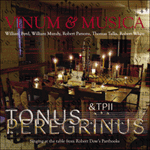 Vinum et Musica
Vinum et Musica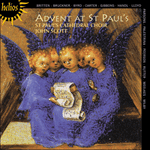 Advent at St Paul's
Advent at St Paul's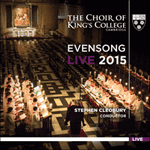 Evensong Live 2015
Evensong Live 2015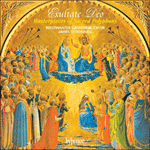 Exultate Deo
Exultate Deo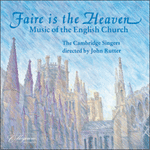 Faire is the Heaven
Faire is the Heaven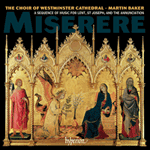 Miserere
Miserere
